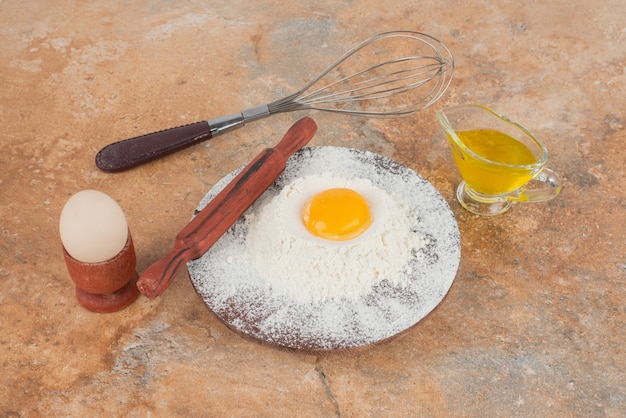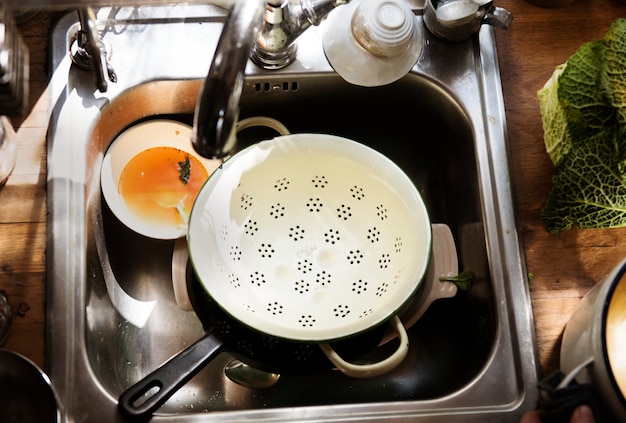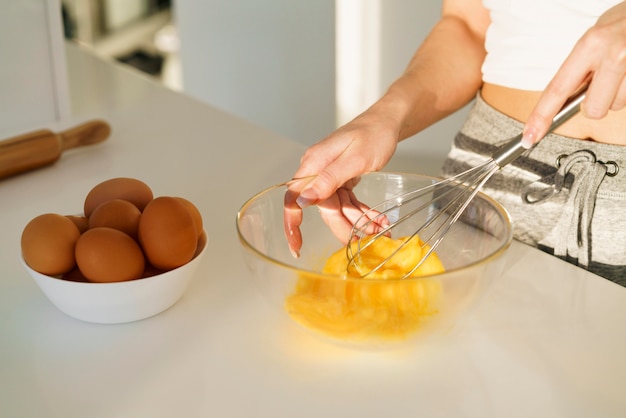I've always considered myself a bit of a scrambled egg aficionado. From childhood breakfasts to leisurely weekend brunches, they've been a constant companion. But it wasn't until I ventured beyond the basic "throw-them-in-a-pan-and-hope-for-the-best" approach that I truly understood the depth of this seemingly simple dish. scrambled eggs, you see, are a canvas for culinary creativity, where texture and flavour intertwine in a delightful dance. It took me years of experimentation, countless burnt offerings, and a healthy dose of trial and error to master the art of the perfect scramble. But now, armed with the knowledge gleaned from my egg-cellent journey, I'm ready to share my secrets with you.
Get ready to embark on a culinary adventure as we delve into the world of scrambled eggs, exploring everything from choosing the right eggs to mastering the delicate art of cooking them to perfection. We'll uncover the hidden nuances that transform a simple breakfast staple into a culinary masterpiece. This is more than just a recipe; it's a journey to discover the joy of crafting perfect scrambled eggs, every time.
(Part 1) Eggcellent Start: Choosing Your Eggs

Why Egg Quality Matters
The truth is, the success of your scrambled egg adventure begins long before you even crack an egg. The foundation of a good scramble lies in the quality of your eggs. You might think any old egg will do, but believe me, the difference is truly noticeable. Imagine starting a painting with a cheap, watery paint; the result will be pale and lacklustre. The same goes for your eggs.
Firstly, consider freshness. A truly fresh egg, just laid, boasts a vibrant, thick white and a plump, prominent yolk. This translates to a smoother, richer, and more flavorful scramble. When buying eggs from the supermarket, pay attention to the sell-by date; the closer it is, the fresher the egg. However, if you can, seek out local, free-range eggs. They often possess a deeper, richer flavour and are likely to be fresher, having travelled a shorter distance from farm to fridge.
Beyond the Shell: Choosing the Right egg size
Now, let's talk about size. The size of your egg doesn't have a huge impact on flavour, but it can affect the volume of your scramble. Large eggs, with their generous yolks and whites, will yield a more substantial portion, perfect for feeding a hungry crowd. However, if you're whipping up a solo breakfast, a medium egg might be just the ticket. Ultimately, the choice is yours, my friend, based on your personal preferences and the occasion.
(Part 2) The Art of Prepping: Getting Your Eggs Ready

Getting Cracking (and Separating)
Now, for the fun part - cracking those eggs. I find it's best to crack them into a separate bowl first. This gives you a chance to inspect them for any stray bits of shell. Discard any suspect eggs, you don't want any unwelcome surprises in your final dish. This step also makes it easier to whisk the eggs together later.
Whisk it, Don't Beat it
Speaking of whisking, I find it's best to whisk the eggs lightly with a fork. You don't want to over-whisk them, just gently blend the whites and yolks together. This will create a nice, even consistency for your scramble. I also add a pinch of salt at this stage. Salt not only seasons the eggs, but also helps to break down the proteins, making them more tender and contributing to that melt-in-your-mouth texture.
A Splash of Milk: A Controversial Twist
Now, for the secret weapon: milk! This is a controversial topic in the scrambled egg world, with some folks swearing by it and others vehemently against it. I'm firmly in the "add-a-splash" camp. I find that a tablespoon or two of milk creates a creamier, more luscious scramble, with a texture that's both smooth and satisfying. However, be careful not to overdo it. Too much milk will result in watery, rather than creamy, scrambled eggs, and that's a culinary crime we want to avoid.
(Part 3) The Cooking Process: Mastering the Technique

The Right Pan for the Job
A great artist always uses the right tools. The same applies to scrambled eggs. A non-stick pan is your best friend in this culinary pursuit. Choose a pan that's the right size for the amount of eggs you're cooking. I usually use a medium-sized pan for two eggs. If you're cooking for a group, you'll need to scale up accordingly.
Low and Slow: A Gentle Approach
Now, for the crucial part - cooking the eggs. The key here is to cook them slowly over a low heat. I usually heat my pan over a medium heat for a minute or two, then reduce it to low before adding the eggs. The idea is to cook the eggs gently, without scrambling them too quickly, allowing the proteins to cook evenly and create that fluffy, creamy texture. Think of it as nurturing a delicate flower; you wouldn't rush its blooming process, would you?
The Gentle Stir: The Art of Patience
As the eggs start to set, use a spatula to gently stir them. Don't over-stir though, you just want to move the eggs around to ensure they cook evenly. If you stir too much, the eggs will become tough and rubbery, resembling a sad, overworked omelette. You want them to be soft and creamy, like a cloud.
Adding Creaminess: The Finishing Touch
As your eggs approach perfection, you can add a bit of butter for extra richness. You can add a knob of butter to the pan as the eggs are cooking or simply stir in a tablespoon of melted butter after the eggs are cooked. Both methods work well, and the choice is really down to personal preference.
The Perfect Finish: Seasoning with Love
Now, for the final touch. Once the eggs are cooked to your liking, remove them from the heat and season them with a pinch of salt and pepper. I like to add a splash of fresh herbs like chives or parsley, but this is optional. This is your moment to add your personal touch, to elevate your scrambled eggs from good to great.
(Part 4) The Art of Texture: Getting It Just Right
Fluffy and Creamy: The Ideal
Let's talk about texture. For me, the perfect scrambled egg is fluffy and creamy. It should be soft and tender, with a slight wobble. It should melt in your mouth, not feel like you're chewing on rubber. To achieve this, it's crucial to cook the eggs slowly over a low heat, stirring gently.
Common Mistakes and How to Avoid Them
Here are some common mistakes to avoid when scrambling eggs:
- Over-whisking: This will make the eggs tough and rubbery. Just a light whisk is all you need. Imagine you're gently coaxing the eggs into a harmonious blend, not attempting to whip them into a frenzy.
- Cooking over high heat: This will cook the eggs too quickly, making them dry and crumbly. Low and slow is the key to success. Think of it as a marathon, not a sprint.
- Over-stirring: Again, this will lead to tough eggs. Just a gentle stir is all you need to ensure they cook evenly. The goal is to create a delicate, even texture, not a homogenous, over-worked mass.
- Not using a non-stick pan: This can lead to the eggs sticking to the pan and becoming a scrambled mess. A good non-stick pan is your culinary ally in this endeavor, ensuring your eggs slide easily and beautifully.
(Part 5) Serving Up Your Masterpiece
The Perfect Plate
Now, it's time to enjoy your masterpiece! I like to serve my scrambled eggs on a warm plate, alongside a piece of toast or a side of bacon. You can get creative with your toppings too. I love adding a dollop of sour cream, a sprinkle of cheese, or a handful of chopped chives.
(Part 6) Mastering the Variations: Exploring Beyond the Basics
Spiced Scrambled Eggs: A Touch of Heat
Once you've mastered the basic technique, you can start experimenting with different variations. For a bit of a kick, try adding some spices to your scramble. A pinch of paprika or cayenne pepper will add a touch of heat, transforming your eggs into a vibrant and flavourful dish. If you're feeling adventurous, you could even try adding some cumin or coriander, for a truly unique and aromatic experience.
Cheesy Scrambled Eggs: A Melty Delight
For a cheesy treat, try adding some grated cheese to your scramble. Cheddar, mozzarella, or even feta would all work well. You can add the cheese to the pan as the eggs are cooking, or stir it in after the eggs are cooked. Just remember, cheese can make the eggs stick to the pan, so keep a close eye on them.
Scrambled Eggs with smoked salmon: A Taste of Luxury
For a more sophisticated twist, try adding some smoked salmon to your scramble. This is a classic combination that's both delicious and elegant. Simply add the smoked salmon to the pan as the eggs are cooking and stir gently. The salty, smoky flavour of the salmon beautifully complements the creamy texture of the eggs.
Scrambled Eggs with Vegetables: A Healthy Twist
If you're looking for a healthier option, try adding some chopped vegetables to your scramble. Spinach, mushrooms, onions, and bell peppers all work well. Just make sure to cook the vegetables first before adding the eggs, as they need a longer cooking time. The addition of vegetables adds a burst of colour and flavour, making your scramble even more satisfying.
(Part 7) Storing and Reheating Leftovers
Storing Your Scramble: Keeping it Fresh
If you have any leftover scrambled eggs, store them in an airtight container in the refrigerator for up to three days. Just remember, the texture will deteriorate as they sit, so it's best to eat them within a day or two.
Reheating Your Scramble: Restoring the Glory
To reheat leftover scrambled eggs, place them in a microwave-safe dish and microwave on high for 30 seconds to a minute, or until heated through. You can also reheat them in a pan on the stovetop over low heat, but be careful not to overcook them, as they can become dry.
(Part 8) Tips and Tricks from My Egg-cellent Journey
Overcoming the Fear of Over-Cooked Eggs
I remember being terrified of over-cooking my eggs when I first started making them. I'd always end up with dry, rubbery scrambled eggs, and I'd be so disappointed. But then I realised it's all about cooking them slowly over a low heat, and being patient. It's a bit like baking, you've got to let them cook through, but not let them burn!
Adding Texture with Herbs and Spices
Once I started experimenting with herbs and spices, my scrambled eggs took on a whole new level of flavour. I love adding a pinch of paprika, a few fresh chives, or even a little bit of chili flakes for a kick. It's amazing how much a little bit of spice can elevate the flavour of your eggs.
The Power of a Good Non-Stick Pan
I've learned the importance of a good non-stick pan. It makes all the difference in ensuring the eggs cook evenly and don't stick to the pan. It also makes clean-up so much easier, leaving you more time to enjoy your delicious creation.
Keep It Simple: Don’t Overcomplicate It
Scrambled eggs are a classic dish for a reason. They're simple to make and can be enjoyed for breakfast, lunch, or dinner. Don't overcomplicate them. Just stick to the basics and you'll be rewarded with a delicious and satisfying meal.
(Part 9) FAQs: Your Scrambled Egg Queries Answered
1. What's the secret to making scrambled eggs fluffy?
The key to making fluffy scrambled eggs is to cook them slowly over a low heat, stirring gently. Don't over-whisk the eggs or over-stir them in the pan, as this will make them tough and rubbery. Imagine you're gently coaxing them into a fluffy state, not trying to beat them into submission.
2. What is the best milk to add to scrambled eggs?
I find that whole milk works best for scrambled eggs, as it creates a creamy, rich texture. You can also use low-fat milk or even cream if you prefer, but be mindful that cream can make the eggs stick more easily.
3. Should I use butter or oil for scrambled eggs?
Both butter and oil work well for scrambling eggs. Butter adds a rich, buttery flavour, while oil helps to prevent the eggs from sticking to the pan. You can use either one, or even a combination of both, depending on your taste preferences.
4. How do I know when scrambled eggs are done?
Scrambled eggs are done when they are just set and no longer runny. They should have a soft, creamy texture, with no trace of liquid remaining. If you’re worried about overcooking them, remove them from the heat a little before they seem completely done, as they will continue to cook a little bit off the heat.
5. Can I add other ingredients to scrambled eggs?
Absolutely! You can add any number of ingredients to your scrambled eggs, such as cheese, vegetables, herbs, spices, or even meats. Just remember to cook any vegetables or meats before adding them to the eggs, as they need a longer cooking time. Get creative and enjoy!
Now, you're ready to tackle those eggs. Go on, give it a try, and see if you can't create your own perfect, fluffy, delicious scrambled eggs. You've got this!
Everyone is watching

How to Cook Frozen Lobster Tails Perfectly: A Step-by-Step Guide
RecipesLobster. Just the word conjures up images of lavish meals, special occasions, and a taste of luxury. But let's...

Pork Fillet Cooking Time: How Long to Cook It Perfectly
RecipesPork fillet, or tenderloin as it's sometimes called, is a real favourite in our house. It's so versatile, and...

Pigs in a Blanket Cooking Time: How Long to Bake for Perfect Results
RecipesAh, pigs in a blanket. Just the name conjures up images of those delightful little parcels of crispy pastry en...

The Ultimate Guide to Cooking Delicious Frankfurters
RecipesLet's face it, we all love a good frankfurter. It's a classic, simple, and always satisfying. But let's be rea...

Wolf Meat Recipes: A Guide to Cooking Wild Game
RecipesLet's be honest, you don't see wolf meat at your local butcher shop every day. It's a bit of a wild card, but ...
